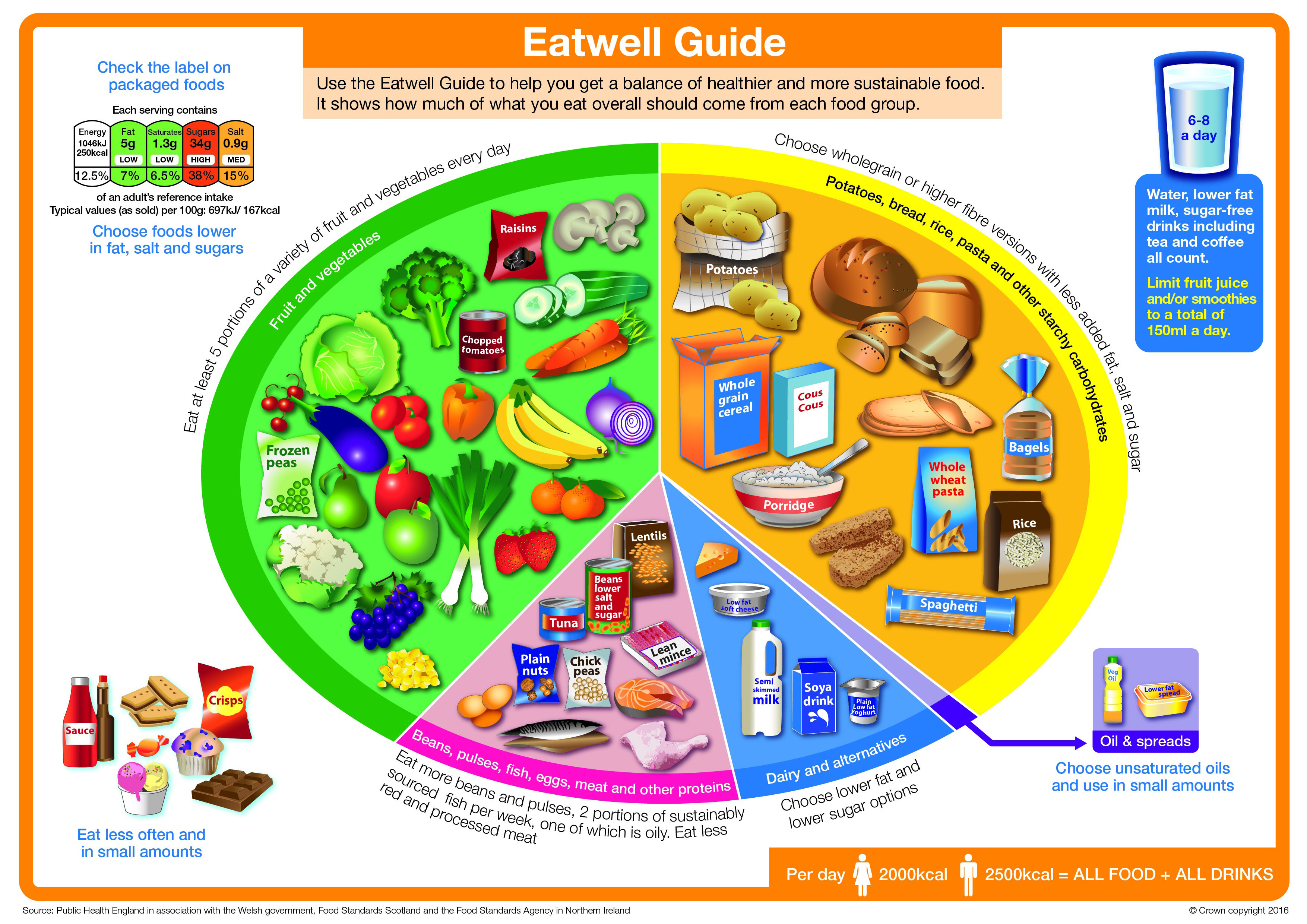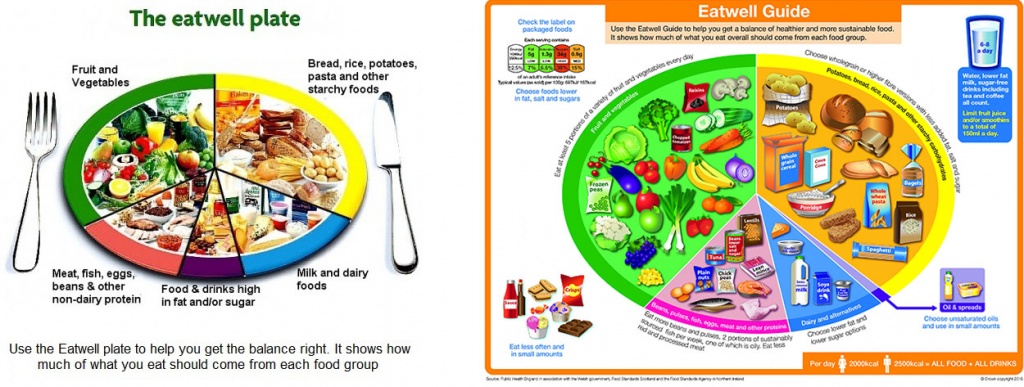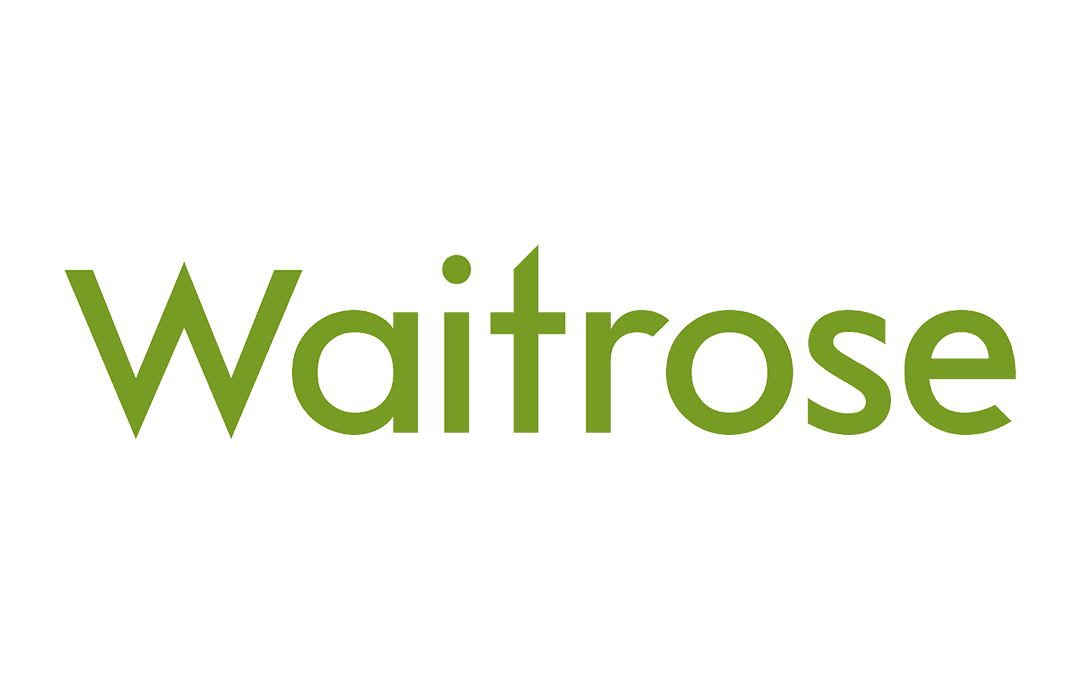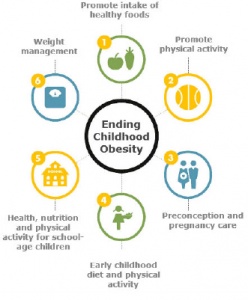
by Nutrilicious | Mar 18, 2016 | Hot Topics in nutrition
Kept under much secrecy, the government revealed the updated Eatwell Plate to the nation on Thursday 17th March following a stakeholder meeting on Wednesday 16th , which we were pleased to attend. Surprising for us, the changes to the new Eatwell Guide went beyond some simple cosmetic adaptations. In the main, the plate, based on exhaustive reviews of the scientific evidence, has embraced more of the 21st Century consumer eating trends and the growing concerns around sustainability. Will it be more effective at improving the population’s poor nutritional status and reduce obesity? As with all dietary guidelines, effective communication and behaviour change strategies that follow will be key.

Can you spot the 13 differences?
The official documentation lists 12 differences, however, we’ve added one more!
- Importance of hydration has finally been embraced! With recommendations to consumer 6-8 glasses of fluid daily: water, sugar free drinks including tea and coffee and milk.
- Front of pack labelling: possibly coming to terms that as much as we would love the nation to be keen cooks, ready meals and take-aways are by far more popular.
- High fat, salt and sugar foods removed altogether: ‘no role in a healthy balanced diet.’ At last, the group that also included healthy unsaturated fat oils and spreads has been better clarified with latter remaining within the Eatwell Guide as a much smaller section (taking up just 1%).
- Calories have been included for adult men and women – to remind consumers that all foods contribute to calories.
- Four of the five food segments renamed: changing the emphasis to embrace more wholegrains and plant foods whilst keeping saturated fat down.
• Bread, rice, potatoes pasta and other starchy foods is now ‘Potatoes, bread, rice, pasta and other starchy carbohydrates’ with an overarching sub-line ‘Choose wholegrain or higher fibre versions with less added fat, salt and sugar.’
• Milk & dairy foods is now ‘Dairy & alternatives’ with the sub-line ‘Choose lower fat and lower sugar options.’
• Meat, fish, eggs, beans and other non-dairy sources of protein is now ‘Beans, pulses, fish, eggs, meat and other proteins’ with the sub-line ‘Eat more beans and pulses, 2 portions of sustainably sourced fish per week, one of which is oily. Eat less red and processed meat.’
• Food and drinks high in fat, sugar and/or salt has now been removed and instead replaced with ‘Oil & spreads’.
- The five food segments re-sized:
• Fruit and vegetables – go up by 7%, now making up 40% of the plate.
• A bigger push for wholegrain carbs – and up by 5% to 38% of the plate. We hope this will help towards the fight against the ‘anti-carb-based on dodgy and misinterpreted science’ brigade. – As well as wholegrain, there is more emphasis (we feel within the full guidance notes) that it’s not carbs that are fattening but what we choose to add to them.
• Dairy and alternatives – almost halving the recommendations from 15% down to just 8% of the plate. We are pleased to see calcium fortified and unsweetened dairy alternatives making a bigger noise here. And interestingly, 1% dairy milks are recommended over semi-skimmed.
• Protein segment making up the same proportion as previously, has significantly been revamped to embrace sustainability and the need for more plant-based protein consumption. With ‘other proteins’ including soya and Mycoproteins. Single portions of meat to be 70g and fish to be sustainably sourced.
- Fruit juice removed from the Eatwell Guide fruit and vegetable visual in this sector, but highlighted in the hydration section with a significant emphasis that no more than 150ml daily consumption.
- Smoothies have lost their halo: previously, smoothies were permitted to count as 2 of our 5-a-day at 125ml per portion. With both smoothies and fruit juice now classified as ‘free sugars’ the consumption of either has been clearly limited to no more than 150ml per day as part of hydration and contributing to just one of our 5-a-day.
- Oils and spreads: now making just 1% of the Eatwell Guide and thankfully no longer considered as part of the high fat, salt and sugar foods. There is good emphasis within the guidance that all fats however add cals and should be limited.
- Additional messages for further guidance – helping consumers better understand the visuals including 8 tips for healthy eating.
Some changes based on qualitative stakeholder and consumer insights, but considered more cosmetic by us:
- No fork and knife
- Change of name from Eatwell Plate to Eatwell Guide
• Both the above changes based on insights that they little reflect how consumers see meals / consume foods.
- Drawn food images rather than photography. Interesting insight that although stakeholders prefer the latter, consumers prefer the former.
Great strides – but will it be enough?
We are disappointed that there continues to be no offer of practical and household portion guides particularly for the carbohydrate and some foods from the protein groups. This will make it difficult for both the consumers and health advisors to provide the real practical much needed approach. We appreciate that it is a challenging task but believe it to be achievable. As Dietitian communicators in public health we are aware of how much the public needs to be shown how to put these guidelines into practice and how much a consistent approach is needed. PHE at the stakeholder meeting mentioned that they have done some preliminary work on this internally but such things like meal plans will not currently feature in the tools and communications, due largely to lack of funding. We were also surprised that no quantitative survey work representative of the population and health advisers using the tool had not been undertaken prior to the focus group work. Perhaps if this had been done these needs would have been prioritised and addressed.
Will this change the health of the nation?
It will all depend on how and who it’s communicated to and what behaviour change strategies will be put into place which as we all know, means funding. With Cameron’s Obesity Strategy expected to be announced in 2016, how much funding is put behind such campaigns will be the true sign of how seriously they are about tackling the health of the nation.
www.gov.uk/government/publications/the-eatwell-guide

by Nutrilicious | Feb 10, 2016 | Retail, Interviews
We recently worked with Waitrose on an exciting health and nutrition project where we truly saw the impact that a dietitian in retail can have on public health and sales. Moira Howie, Waitrose’s Manager in Nutrition and Health kindly agreed to tell us more about her journey. Here are the highlights.
When the opportunity to be a retail nutritionist came my way… I couldn’t resist. I knew that what people ate impacted their health so what better way to bring about changes than by helping to shape their weekly shopping basket. It sounds simple and easy but in reality the general public are quite resistant to change and those good intentions don’t always translate into practical action.
Adopting a multi-faceted approach to helping consumers choose a healthier diet yields the best results. The early creation of an online nutrition advice service containing a wealth of topical information helped to grow and build consumer trust in accessing sensible and practical advice. Consumers seem to struggle in getting information that meets their specific dietary needs therefore bespoke shopping lists are always in demand. New technology has changed the shape of this information from paper to screen to phone but the requests remain the same “help me know the things I can eat as opposed to the things I can’t!” This essence of practical help extends through all publications from inspirational recipe cards carrying our Living Well logo to weekly and monthly columns on topical health concerns. But communication in itself is never going to solve the wider public health problems.
The changes required are more fundamental ranging from policy to product. Developing nutrition policy and setting strategic direction to deliver the ambition is at the heart of what we do. Policy needs to reflect latest nutritional thinking and be commercially appropriate for the retail setting. This approach enables our business to play a key role in helping to reduce calories, saturated fat, sugar and salt – those nutrients of concern in the UK diet and also to set goals for increasing fibre, vegetables, fruit and oily fish intakes to help achieve dietary balance. The nutrition policy influences new product development, drives nutrition reformulation and helps our suppliers to create great tasting products.
While scientific recommendations provide us with the evidence and the numbers it is the translation of these into real foods for our shopping baskets and recipes for our family tables that will make the difference. Successive governments have a keen interest in a healthier population and recognise that collaborative working achieves more. The Public Health Responsibility Deal has overseen decreasing salt levels in the UK diet, introduced the ‘easy to use’ front of pack labelling system that is now the norm across much of the food industry. These are significant successes and retailing will continue this momentum to bring about similar changes which impact public health in a positive way.
Moira Howie February 2016
Manager, Nutrition & Health

by Nutrilicious | Feb 3, 2016 | Health Awareness Events, Hot Topics in nutrition
As weight-busting January came to an end it brought to light a new, hard-hitting report from the WHO Commission on Ending Childhood Obesity (ECHO), with the alarming headline that, globally-speaking, at least 41 million children aged under five years are obese or overweight (1).
Applying the emergency brake on obesity: Whose role is it?
Unsurprisingly, The ECHO report, based on a review of the evidence, highlights childhood obesity as a complex and multidimensional problem. However, according to the report, the greatest obstacle to effective progress on reducing childhood obesity is a lack of political commitment and a failure of governments and other actors to take ownership, leadership and necessary actions. The WHO calls on governments to take effective leadership on obesity by incorporating large-scale cultural environmental and behavioural change without which change simply will not happen.
The knowns
We know that obesity has a massive impact on a child’s quality of life, from physical as well as psychological perspectives; studies also show that obese children face significant risk of obesity in adulthood, which itself poses major health and economic consequences for families and wider society (2).
The report paints a bleak picture that the prevalence of children being overweight under the age of five has risen, from 4.8% in 1990 to 6.1% in 2014, or an increase of 10 million children. On closer scrutiny, the statistics reveal that the most significant change in prevalence has been in Asia and Africa, driven by globalisation and urbanisation leading to obesogenic environments. Another major driver highlighted was the marketing of ‘unhealthy foods and non-alcoholic beverages’ which feature heavily in the recommendations.
The answers
The report proposes a set of policy recommendations to address three strategic objectives:
- To tackle the obesogenic environment and norms.
- To reduce the risk of obesity during critical periods in the life-course —preconception and pregnancy, infancy and early childhood, and older childhood and adolescence.
- The provision of treatment for children who are obese to improve their current and future health. To unpack this further, six broad recommendations are highlighted:

1 Promote intake of healthy foods
Implement comprehensive programs that promote the intake of healthy foods and reduce the intake of unhealthy foods and sugar-sweetened beverages by children and adolescents.
2 Promote physical activity
Implement comprehensive programs that promote physical activity and reduce sedentary behaviours in children and adolescents.
3 Preconception and pregnancy care
Integrate and strengthen guidance for the prevention of non-communicable diseases with current guidance on preconception and antenatal care.
4 Early childhood diet and physical activity
Provide guidance on, and support for, healthy diet, sleep and physical activity in early childhood and promote healthy habits and ensure children grow appropriately and develop healthy habits.
5 Health, nutrition and physical activity for school-age children
Implement comprehensive programmes that promote healthy school environments, health and nutrition literacy and physical activity among school-age children and adolescents.
6 Weight management
Provide family-based, multi component, lifestyle weight management services for children and young people who are obese.
While the report highlights, the limited potential of any single intervention to provide a solution, within these overarching recommendations are more specific targets, focussed on tackling the obesogenic environment.
Targets for the food industry feature prominently. Within the first recommendation, there is a call to implement ‘effective taxation on sugar-sweetened beverages’ and to implement context-specific nutrition information, and ‘interpretive’ front-of-pack labelling. The food and drink industry, retailers and marketing stakeholders are called upon to clampdown on junk food marketing with the report recommending that advertisements for ‘unhealthy products’ should be banned from children’s TV, schools and sports facilities. Sizing up is also singled out as a particular issue to address and there is scope and opportunity for the industry to address appropriate portion sizes.
Schools also offer a key opportunity for action and the report’s recommendations focus on: standards for school meals; elimination of so-called ‘unhealthy foods’, such as sugar-sweetened beverages and energy-dense, nutrient-poor foods, in the school environment; informed nutrition education as part of the core curriculum; and ensuring levels of physical activity for all children, meet current recommendations, with comprehensive programmes that reduce sedentary behaviours in children.
Similarly, health professionals have a major role to play if the recommendations are to be in any way implemented which will take considerable investment in the work-force to achieve the skill-sets required, as well as the resources. The roles that schools and health professionals have to play can only be realised by ensuring that there are measures and funding in place to support them. Even before birth, the behavioural and biological responses of a child to the obesogenic environment can be shaped by processes (3). x7Hanson, MA and Gluckman, PD. Early developmental conditioning of later health and disease: physiology or pathophysiology?. Physiol Rev. 2014; 94: 1027–1076 CrossRef | PubMed | Scopus (30)See all References7 Having clear guidelines which start to tackle that environment is a starting point with independent research being used to show what works. This must start with giving schools and health professionals the support to run evidence-based interventions: for example, dietitians having a role in ante-natal settings to advise mothers-to-be on healthy diets for themselves, and as gatekeepers for the whole family; schools to have teachers who are able to deliver nutrition education as part of the curriculum, as well as giving space in the school environment for more movement. One of the recommendations is to ‘make food preparation classes available to children, their parents and caregivers’ – even to achieve this single measure, vast investment and training is needed.
Caterers also have a crucial role, especially those working within the public sector such as in schools and hospitals and early-years settings and are called upon to meet the recommendations to limit consumption of foods high in fat, sugar and salt; ensuring availability of healthy foods.
Getting to the known unknowns
Whilst some of the report’s recommendations are in place already in the UK, for example, the National Child Measurement Programme to help monitor weight changes http://www.nhs.uk/Livewell/childhealth1-5/Pages/ChildMeasurement.aspx the UK has yet to put in place resource for dealing with those found to be overweight as well as making recommendations for weight gain in pregnancy. Research priorities are needed so that the evidence is in place to make UK-specific recommendations. But, as the McKinsey report (5) highlighted, lack of research should not be a barrier to action.
So does accountability now lie within government versus local communities, individual responsibility etc? We have long known and as the ECHO report states ‘without joint ownership and shared responsibility, well-meaning and cost-effective interventions have limited reach and impact’. However, this joined up thinking and action has never happened and is unlikely to happen without clear co-ordinated leadership, appropriate powers and accountabilities with specific targets. Will Cameron now lead us with a ground breaking strategy for the UK that is lead right from the top with a COBRA style committee to truly address the nation’s health crisis in his forthcoming childhood obesity strategy? Will he be brave or will he leave it to his successors to sort out? No government has ever achieved this to date. Yet we have never needed it more than it is needed now. Let’s hope he has his eyes wide open on and the determination focus and foresight needed.
References
Commission on Ending Childhood Obesity. Report of the Commission on Ending Childhood Obesity. World Health Organization, Geneva; 2016 http://www.who.int/end-childhood-obesity/en/ (accessed Jan 29, 2016)
Litwin, SE. Childhood obesity and adulthood cardiovascular disease: quantifying the lifetime cumulative burden of cardiovascular risk factors. J Am Coll Cardiol. 2014; 64: 1588–1590
Hanson, MA and Gluckman, PD. Early developmental conditioning of later health and disease: physiology or pathophysiology? Physiol Rev. 2014; 94: 1027–1076
van Jaarsveld CHM, Gulliford MC. Childhood obesity trends from primary care electronic health records in England between 1994 and 2013: population-based cohort study. Arch Dis Child. doi:10.1136/archdischild-2014-307151
McKinsey Global Institute. Overcoming Obesity: An Initial Economic Analysis. McKinsey Institute; 2014 http://www.mckinsey.com/Insights/Economic_Studies/How_the_world_could_better_fight_obesity (accessed Feb 3, 2016)

by Nutrilicious | Jan 14, 2016 | Health Awareness Events, Hot Topics in nutrition
The National Obesity Forum has called for a tax on sugary drinks this week at more than double the level recommended by Public Health England, in a manifesto to improve public health launched to mark the beginning of its JanUary campaign (formerly National Obesity Awareness Week). The manifesto was presented at the All-party Parliamentary Group on Adult and Childhood obesity at the House of Commons re-launched today which we attended.
The Forum, which comprises of practicing healthcare professionals and clinicians, has claimed that only a 50 percent tax on sugary drinks will prompt a change in consumer behaviour. It has, however, rejected calls for a tax on food products, claiming such a move would unfairly penalise low-income families – instead insisting the Government should abandon the Responsibility Deal and mandate the reformulation of foods to reduce levels of fats, sugars and salts.
Other recommendations in the Forum’s manifesto, include GPs routinely measuring the weight and BMI of young children, including water in Public Health England’s relaunched ‘eat well’ plate, banning fast food outlets near schools, and insisting on a watershed ban for junk food advertising.
The Forum has also called for the expansion of specialist non-surgical weight management treatment services across the UK, and improved information on local weight management resources and services for GPs and nurses.
Professor David Haslam, Chairman of the National Obesity Forum, said: “The measures we’ve proposed could be relatively easily implemented with substantial benefits to public health. There have been repeated warnings about the health of the population, but we remain in the midst of an obesity epidemic. Tackling this problem requires immediate and concerted action. We need to improve and extend the treatment services available. We also need to educate and, where appropriate, change consumer behaviour.” “Anything less than a 50 percent tax on sugary drinks will be insufficient as a disincentive to consumers. We don’t currently support taxing food products – this would be unfair to particularly low-income families. But sugary drinks have no place in anyone’s diet.”
Unfortunately this meeting was very poorly attended by MPs. Let’s hope that this is not a sign of things to come with Cameron’s much anticipated childhood obesity strategy.
The National Obesity Forum is encouraging members of the public to make healthy New Year’s Resolutions and participate in a sugar reduction challenge as part of the JanUary campaign.
www.jan-u-ary.co.uk
www.jan-u-ary.co.uk/wp-content/uploads/2016/01/NOF-manifesto-v4-compressed.pdf

by Nutrilicious | Jan 14, 2016 | Health Awareness Events
We enjoyed attending Parliament yesterday. However, it was not the usual kind of meeting! Originally set up to test MPs knowledge of healthy eating, hydration and physical activity against primary school pupils in the House of Common. However, MPs not wishing to be outdone by their juniors, decided instead to head each of the primary school teams.
MPs including Steve Pound, Carol Monaghan and Rupa Huq joined teams from Berrymede Junior School, Horsenden Primary and Montpelier Primary in the quiz, which was chaired by former Blue Peter presenter Helen Skelton. The quiz was based on the Eat Like A Champ programme, a Change4Life partner scheme designed to promote healthy diet and exercise amongst primary schools pupils aged nine and 10 years. Ms Skelton has previously completed the Namibia ultra-marathon, kayaked the length of the Amazon, and to the South Pole.
The quiz was part of the JanUary campaign, which is led by the National Obesity Forum to encourage healthy choices amongst the public and tackle a growing obesity crisis. Participants faced six rounds of lively questions with each team of school pupils also asked to deliver a presentation on why healthy living is important.
The quiz was won by Montpelier Primary on a tie-break round.
The competitive nature of both MPs and pupils soon came to the fore with speed-lightning pressing of their buzzers before Helen Skelton had a chance to finish the questions. Disputing amongst teams also ensued forcing Helen Skelton to make some hard marking decisions. Questions focused predominantly on the food groups from the Eatwell Plate. The most enchanting part of the day, came when representatives from each school braved the audience to present their prepared speeches on the importance of exercise and physical activity. The pupils’ motivation, enthusiasm and level of knowledge was a true inspiration to all.
The Eat Like A Champ programme is run by Danone and was developed in collaboration with the British Nutrition Foundation.
Professor David Haslam, Chairman of the National Obesity Forum, said:
“Of course this a bit of fun, but it’s making a very important point. Namely that we need to ensure our children are introduced to good nutrition and hydration habits at a young age. We know from the National Child Measurement Programme that the number of overweight and obese young people remains high, and that this is a particular problem in deprived areas. Many children are sedentary and consume large quantities of poor quality foods high in salt, sugar and trans-fats.
“This must be addressed if we’re to avoid storing up problems for the future, and condemning children to poor health outcomes. Initiatives like Eat Like A Champ are absolutely vital in teaching good habits at a young age.”
Adam Grant, Managing Director of Danone Ltd, said:
“We are extremely proud of Eat Like A Champ, which since 2010 has inspired 100,000 children across the country to adopt the healthy choices of champions they admire. Independent research has shown Eat Like A Champ has a positive impact, and we are delighted to be working with partners such as the National Obesity Forum and the Mayor of London’s Healthy Schools initiative to encourage even more schools to take part.”
The National Obesity Forum and supporters of JanUary are encouraging the pubic to commit to healthy New Year’s Resolutions throughout the campaign (11-17 January).
www.jan-u-ary.co.uk
www.eatlikeachamp.co.uk
www.nationalobesityforum.org.uk







